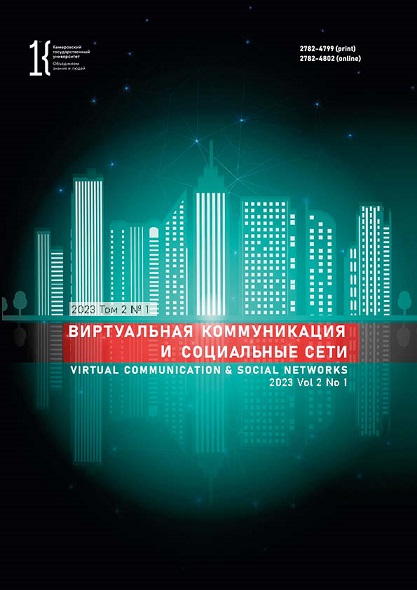Novosibirsk, Russian Federation
Tomsk, Tomsk, Russian Federation
Tomsk, Tomsk, Russian Federation
Cherepovets, Russian Federation
In addition to the environmental data (i.e., data that has been produced and collected by professional ecologists to solve certain environmental problems), other sources of open data can be used to study environmental problems. For example, data created by users for other purposes and extracted from social media can be used to study biodiversity, monitor environment and analyze environmental practices. The article represents a summary of such an empirical study that featured messages about air pollution in the city of Cherepovets published in the VKontakte social network. The study covered the period from January 01, 2020, to October 31, 2022. The methodology included the following steps: selecting relevant network communities; uploading and classifying the relevant messages; thematic modeling and content analysis. The sample included 48 messages that introduced the problem of air pollution in Cherepovets. The PolyAnalyst data analysis platform revealed the following most common phrases: polluting substance, atmospheric air, harmful substance, ammonia emission, liquid complex fertilizers, ammonia concentration. The article also contains a list of industrial enterprises mentioned as polluting agents. The results illustrate the opinions of social net users about the quality of air in Cherepovets. It can be concluded that social networks might help monitor the interest in environmental problems, because they shape the environmental agenda ahead of television and other information sources.
air quality, internet ecology, digital footprints, social networks, VKontakte, data mining, monotowns, Cherepovets
1. Belik I. S., Kamdina L. V. Analysis of the relationship between human impact and quality of population life (on the example of Sverdlovsk and Chelyabinsk regions). Bulletin of Chelyabinsk State University, 2018, (7): 39-48. (In Russ.)] https://doi.org/10.24411/1994-2796-2018-10705
2. Bronnikov I. A., Belousov G. F., Gorbachev M. V. Factors of formation and development of regional environmental protest movements in modern Russia. Vestnik Tomskogo gosudarstvennogo universiteta. Filosofiya. Sotsiologiya. Politologiya, 2021, (59): 214-223. (In Russ.)] https://doi.org/10.17223/1998863X/59/20
3. Vasenina I. V., Sushko V. A. Influence of industrial infrastructure on the ecology of the region and quality of life of local population. Sociology, 2020, (2): 205-214. (In Russ.)] https://www.elibrary.ru/ijqcpz
4. Golbraikh V. B. News consumption by members of virtual environmental protest communities (on the example of the conflict over a landfill in Arkhangelsk oblast). Tomsk State University Journal, 2021, (472): 56-63. (In Russ.)] https://doi.org/10.17223/15617793/472/7
5. Dunaeva D. O. Methodology for collecting data from open online sources to assess the quality of life of the population (using the example of the social network "VKontakte"). Prospects of fundamental sciences development: Proc. XIX Intern. Conf. of students, postgraduate students, and young scientists, Tomsk, 26-29 Apr 2022. Tomsk: TPU, 2022, 14-16. (In Russ.)] https://www.elibrary.ru/dsuvyp
6. Ermolaeva P. O., Ermolaeva Yu. V., Basheva O. A. Digital environmental activism as the new form of environmental participation. Russian sociological review, 2020, 19(3): 376-408. (In Russ.)] https://doi.org/10.17323/1728-192x-2020-3-376-408
7. Rastorguev S. V., Tyan Yu. S. Protest eco-activism in the digital environment (on the example of the "Krasnoyarsk case"). Monitoring of Public Opinion: Economic and Social Changes, 2021, (6): 53-75. (In Russ.)] https://doi.org/10.14515/monitoring.2021.6.2017
8. Rybakova M. V., Zvereva M. M. The environmental situation in Moscow: assessment of the dynamics of public opinion based on the results of polls in 2013-2022. Vlast, 2022, 30(5): 156-162. (In Russ.)] https://doi.org/10.31171/vlast.v30i5.9256
9. Sokolov A. V., Belyakov A. A. Transformation and support of environmental agendas in protest campaigns on social network sites. Vestnik Tomskogo gosudarstvennogo universiteta. Filosofiya. Sotsiologiya. Politologiya, 2022, (67): 202-215. (In Russ.)] https://doi.org/10.17223/1998863X/67/18
10. Shchekotin E. V., Goiko V. L., Basina P. A., Bakulin V. V. Using machine learning to study the population life quality: methodological aspects. Digital Sociology, 2022, 5(1): 87-97. (In Russ.)] https://doi.org/10.26425/2658-347X-2022-5-1-87-97
11. Boldrocchi G., Storai T. Data-mining social media platforms highlights conservation action for the Mediterranean critically endangered blue shark Prionace glauca. Aquatic Conservation: Marine and Freshwater Ecosystems, 2021, 31(11): 3087-3099. http://dx.doi.org/10.1002/aqc.3690
12. Chamberlain J. Using social media for biomonitoring: how Facebook, Twitter, Flickr and other social networking platforms can provide large-scale biodiversity data. Advances in Ecological Research, 2018, 59: 133-168. https://doi.org/10.1016/bs.aecr.2018.06.001
13. Hale R. L., Cook E. M., Beltrán B. J. Cultural ecosystem services provided by rivers across diverse social-ecological landscapes: a social media analysis. Ecological Indicators, 2019, 107. https://doi.org/10.1016/j.ecolind.2019.105580
14. Jarić I., Bellard C., Correia R. A., Courchamp F., Douda K., Essl F., Jeschke J. M., Kalinkat G., Kalous L., Lennox R. J., Novoa A., Proulx R., Pyšek P., Soriano-Redondo A., Souza A. T., Vardi R., Veríssimo D., Roll U. Invasion culturomics and iEcology. Conservation Biology, 2021, 35(2): 447-451. https://doi.org/10.1111/cobi.13707
15. Jarić I., Correia R. A., Brook B. W., Buettel J. C., Courchamp F., Di Minin E., Firth J. A., Gaston K. J., Jepson P., Kalinkat G., Ladle R., Soriano-Redondo A., Souza A. T., Roll U. iEcology: harnessing large online resources to generate ecological insights. Trends in Ecology & Evolution, 2020, 35(7): 630-639. https://doi.org/10.1016/j.tree.2020.03.003
16. LaDeau S. L., Han B. A., Rosi-Marshall E. J., Weathers K. C. The next decade of big data in ecosystem science. Ecosystems, 2017, 20(2): 274-283. https://doi.org/10.1007/s10021-016-0075-y
17. Ladle R. J., Correia R. A., Do Y., Joo G.-J., Malhado A. C. M., Proulx R., Roberge J.-M., Jepson P. Conservation culturomics. Frontiers in Ecology and the Environment, 2016, 14(5): 269-275. https://doi.org/10.1002/fee.1260
18. Lin C. C. Ecoinformatics: a review of approach and applications in ecological research. Proceedings of the National Institute of Ecology of the Republic of Korea, 2020, 1(1): 9-21. https://doi.org/10.22920/PNIE.2020.1.1.9
19. Michel J.-B., Shen Y. K., Aiden A. P., Veres A., Gray M. K., Pickett J. P., Hoiberg D., Clancy D., Norvig P., Orwant J., Pinker S., Nowak M. A., Aiden E. L. Quantitative analysis of culture using millions of digitized books. Science, 2011, 331(6014): 176-182. https://doi.org/10.1126/science.1199644
20. Young J. C., Arthur R., Spruce M., Williams H. T. P. Social sensing of heatwaves. Sensors, 2021, 21(11). https://doi.org/10.3390/s21113717















